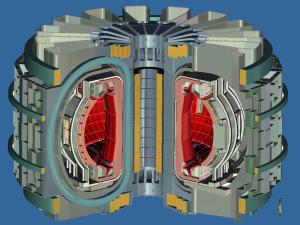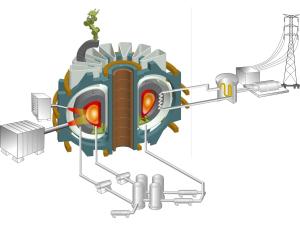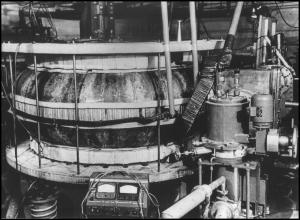After ITER

Although the timeline, the technical specifications and the level of determination vary from one Member to the next, the objective is the same for all: building the machine that will demonstrate industrial-scale fusion electricity by 2050. (Photo: Korea's K-DEMO project)
Decades of fusion research and generations of fusion devices have contributed to the design of ITER. And ITER, in its turn, is contributing to the design of the next generation of machines—DEMO—that will bring fusion research to the threshold of a prototype fusion reactor and closer to tokamak energy.
The knowledge and the know-how garnered during the design, construction, commissioning and scientific exploration phases of ITER is highly valuable for the conception of the tokamak energy machines to follow, which will explore continuous or near-continuous (steady-state) operation, investigate efficient energy capture systems, achieve power output in the Q-value range of 30 to 50 (as opposed to ITER's 10), and test the large-scale production of electrical power and tritium fuel self-sufficiency. “DEMO,” which is used in the international fusion community as a general term to describe these machines, would be a simpler machine than ITER, with fewer diagnostics and a design more targeted to the capture of energy than to the exploration of plasma regimes. Different conceptual DEMO projects are under consideration by all ITER Members.
DEMO projects
China is planning a DEMO-level device by building the China Fusion Engineering Demo Reactor (CFEDR). The CFEDR will serve as a bridge between ITER and commercial fusion power plants with the stated objective of demonstrating 1.5 to 3 GW of fusion power output, a Q of 15 to 30, and tritium self-sufficiency. In complement, the Comprehensive Research Facilities for Fusion Technology (CRAFT) is exploring key technologies for the DEMO device such as superconducting magnets and divertor technologies, while the BEST project (Burning plasma Experimental Superconducting Tokamak, expected to be completed in 2027) will be open to international researchers as part of China's international science program focused on burning plasma research. See further information here.
Europe is planning a DEMOnstration power plant (DEMO) by 2050 as the electricity-producing machine that follows ITER. Conceptual design is progressing on this facility that aims to demonstrate the technological and economic feasibility of fusion energy by producing about 500 MW of net electricity, as well as tritium self-sufficiency. The design team is currently focusing on its choice of breeding blanket, divertor technology, and first-wall design, with several design options under consideration. A plasma-based volumetric neutron source (VNS) facility is proposed in the near term to test fusion nuclear technologies under consideration for DEMO. See further information here and here.
Japan is planning the completion of a JA-DEMO device in the 2040s-2050s to demonstrate steady and stable power generation beyond several hundreds of MW and fusion output of 1500 MW or higher. JA-DEMO will be designed to demonstrate tritium self-sufficiency, plant availability and a positive energy balance across the plant. See further information here.
India is proposing to build a fusion pilot plant with fusion power of 200–300 MW to establish the power performance, tritium breeding and its re-use over sufficiently long pulses, and electricity production before building a compact DEMO reactor that can be replicated on a commercial scale. No timeline has been published. See further details here.
Korea is planning a steady-state demonstration reactor called K-DEMO, a tokamak reactor that will demonstrate net electrical power after 2050. A test facility named SUCCEX (SUper Conducting Conductor EXperiment) is under construction as a prerequisite for the development of the K-DEMO toroidal field magnets with a peak field of 16 Tesla. As part of the 2024 Strategy for Accelerating Fusion Energy Realization plan, Korea announced a new intermediary step before K-DEMO, the Compact Pilot Device (CPD). Construction on the CPD is planned to begin in 2030 with the goal of demonstrating an ignited plasma with internal heating only and tritium self-sufficiency within a decade. See further details about SUCCEX here and the CPD here. Korea is also planning a Virtual DEMO (V-DEMO)—a fusion power plant built in a digital space based on supercomputing, artificial intelligence, and digital twin technologies—to aid in the design activities for K-DEMO.

Korea's projected K-DEMO: a tokamak with a 6.65-metre major radius (as compared to ITER's 6.21 metres), a peak TF field of ~16 Tesla, and a TF field at plasma centre of ~7.6 Tesla.
Russia is planning a tokamak-based DEMO-RF by 2055 to demonstrate gigawatt levels of electric power with deuterium-tritium (D-T) fusion reactions. Under consideration is a fusion-fission hybrid facility with high-temperature superconducting magnets and liquid metal plasma-facing components (first wall and divertor). Before DEMO-RF, Russia is planning to build DEMO-FNS by 2033, a (fusion-fission) hybrid reactor with D-T fusion power of 40 MW (see more information here). There are also plans for a tokamak with reactor technologies (TRT) that could be completed by 2030.
The United States has announced a strategy to clear the path to commercial fusion energy by developing regulatory frameworks, financing R&D, supporting essential supply chains, providing education and training, and engaging the public. Through public support of national laboratories, universities and private industry, the United States is fostering the development and emergence of different DEMO concepts. See further information here.
Other installations with diverse characteristics and objectives are planned to conduct complementary research and development in the areas of advanced material development, tritium self-sufficiency, and heat exhaustion. Beyond DEMO, the final step to producing fusion energy would be the construction of prototype reactors, fully optimized to produce electricity competitively. The timescale for such a prototype depends heavily on political will and the sense of global urgency.



